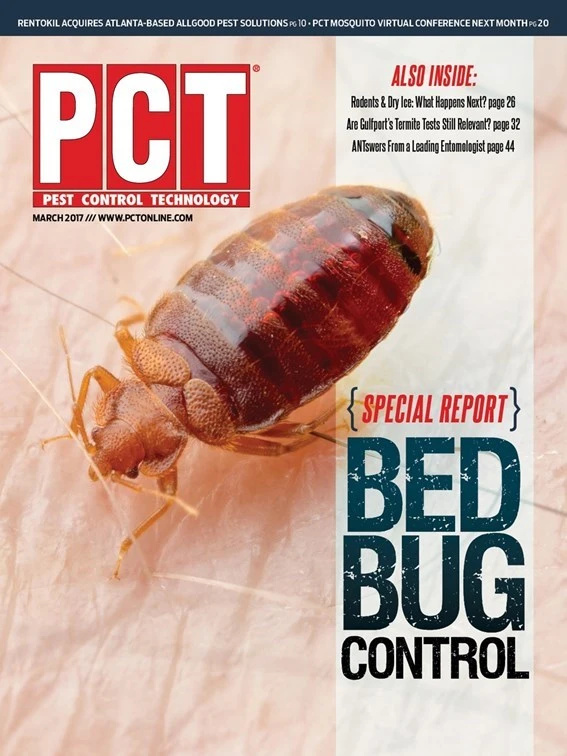
Editor’s Note: The following was adapted from Techletter, a biweekly publication from Pinto & Associates, Mechanicsville, Md. To subscribe, visit www.techletter.com or call 301/884-3020.
While they only rarely invade homes and other buildings, harvester ants are still a pest that must be dealt with by our industry. In areas where they occur, harvester ants often nest in the yard around a home. The workers strip large areas of vegetation, up to 35 feet in diameter, from around their nest. More importantly, however, like fire ants, they pack a mean sting.
THAT STING! If you ever sit on a harvester ant nest you will remember the experience for a long time! An angry harvester ant first locks her jaws tightly into you…so tightly that her head will tear off before she can be pulled loose…and then she jabs in her stinger and injects a toxic venom. In fact, of all insect-produced venoms, that of the harvester ant is probably the most toxic, even more so than the fire ant.
The intense, burning pain of the sting normally lasts 48 hours, and has been described as “ripping muscles or tendons” and “turning a screw in the flesh.” The initial pain may be combined with “gooseflesh” and sweating around the bite site, followed by lingering pain in nearby lymph glands. A purplish hemorrhagic spot typically appears at the site of the sting, followed by a small blister with a halo of inflamed tissue. Some people experience an allergic reaction to the sting, even anaphylactic shock in extreme cases.
Some species of harvester ant have reverse barbs on their stings, like honey bees. The stinger/poison glands pull free and remain inside, pulsing in additional venom.
Before the introduction of the red imported fire ant, harvester ants were considered to be the most “ferocious” of all American ants. Yet, for most of the year, harvester ants are only moderately aggressive; if someone steps on a nest, usually only one or a few ants will attack. However, they often become much more aggressive during those relatively brief periods when swarmers are leaving the nest. The swarmers, or winged reproductives, are vulnerable to predation. To protect them, worker ants become strikingly aggressive. The California harvester ant and the western harvester ant are usually much more aggressive and vicious when disturbed than is the Florida harvester ant. But in any case, harvester ant nests should be treated with caution.
HARVESTER HABITS. The “harvester” part of their name comes from the fact that worker ants gather and harvest seeds to warehouse in their underground nest. The seeds are used as needed and their stored seed stock appears to be “rotated” to prevent spoilage, just like good practice in commercial warehouses.
Harvester ants most often are pests in sunny and dry agricultural fields, orchards and range lands. But they also nest in lawns and yards, and can become a stinging hazard around homes and on paths, picnic areas, athletic fields and playgrounds. They’re expert foragers, sometimes ranging hundreds of feet from the nest. They occasionally enter garages or sheds and pilfer bagged grass seed and bird seed.
A harvester ant nest is typically a mound in open ground. A nest extends deep below the surface; in some cases more than 20 feet down. There may be more than one entrance. Most species of harvester ant clear the vegetation in a circle around the nest opening. These cleared areas may be from a few feet in diameter up to 35 feet, and are often surrounded by a ring of pebbles or debris.
CONTROL. Nests are easy to locate because of the circle of cleared vegetation surrounding them. Unfortunately, because harvester ants nest so deeply in the ground, mound drenches with insecticides and traditional non-chemical approaches such as pouring boiling water into nests or digging up nests are not likely to be effective. Effective controls include the following:
- Baits containing an IGR. Some fire ant baits are labeled for harvester ant control and have proved effective.
- Direct mound treatment by deep injection of an insecticide liquid (usually with a termite rig) or aerosol (high pressure with a long probe), or by applying an insecticide dust in and around the mound entrances.
- Perimeter treatment of structures and areas to be protected using a non-repellent insecticide; also treatment of foraging trails both indoors and out.
The authors are co-owners of Pinto & Associates.
WANT MORE?
Enter your email to receive our newsletters.

Explore the March 2017 Issue
Check out more from this issue and find your next story to read.
Latest from Pest Control Technology
- Envu Introduces Botanical-Based Insecticide to Treat Mosquitoes
- Massey Services' Ed Dougherty Announces Retirement
- Cook's Pest Control Brandon Martin Uses First Responder Training to Save Customer's Life
- VPMA Board Member RJ Mitchell Publishes Children's Book
- NPMA Shares Resources for National Pest Management Month
- Fieldster Launches New Next-Generation Mobile App
- Coalmarch Announces Transition to Private Ownership
- Termatrac Introduces iTraker Pro








